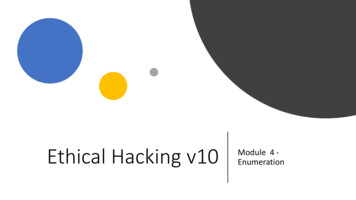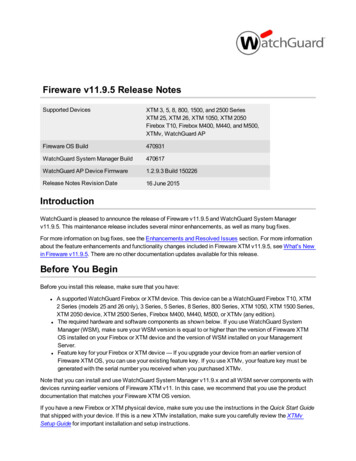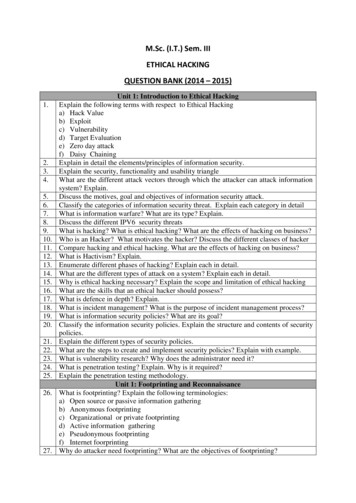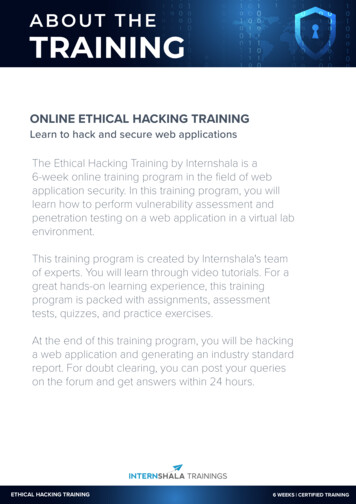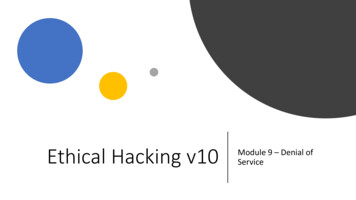
Transcription
Ethical Hacking v10Module 9 – Denial ofService
Denial of Service
Goals Learn Denial of Service (DoS)/DistributedDenial of Service (DDoS) Attacks Understand Various Dos/DDoS AttackTechniques Understand Botnet Network Understand DoS/DDoS Attack Tools Understand Detection Techniques forDoS/DDoS Understand DoS/DDoS Countermeasures Learn DoS/DDoS Penetration Testing
Module 9.0 Denial of Service 9.19.29.39.49.69.7DoS/DDoS ConceptsCommon DoS/DDoS Attack TechniquesAdditional DoS Attack TypesBotnetsDoS CountermeasuresDoS Penetration Testing
9.1 DoS/DDoSConcepts
Denial of ServiceAttacks (DoS andDDoS) A DoS attack (denial of service) is anetwork-based attack that prevents thetarget from performing its normalduties A DDoS attack (distributed denial ofservice) is a DoS attack where manyattackers are coordinated to attack onetarget Types: Flooding servers with network trafficCrashing a serviceConsuming available resourcesProtocol-, OS-, or service-based
What are Distribute Denial of Service Attacks(DDoS)? Involves multiple compromised systems used to attack one target This causes DoS for the targeted system Botnets are used to attack a single system
How DDoS Attacks Works Attacker designates a handler system Handler infects many computers via internet Zombie systems attack target server
Attack Categories Volumetric Attacks Designed to consume bandwidth of target Fragmentation Attacks Removes ability for target to reassemble fragmented packets TCP State-Exhaustion Attacks Designed to consume connection state tables in network infrastructurecomponents Application Layer Attacks Designed to consume app resources/service so they are not available to users
Stress Testing Stress Testing is the process of determiningthe ability of a computer, network,application, or device to maintain aspecified level of effectiveness underunfavorable conditions Basically invoking a DoS attack Use scripts, bots, and other tools Often used to determine the level of traffica website can handle When used in pen testing, it will bedestructive Pen testers should get specificauthorization Clients must be aware of theimplications of the testing
9.2 CommonDoS/DDoSAttack Types
SYN Attack Attacker sends significant number of SYN requests to target usingfalse IP addresses Target machine responds with SYN ACK and waits for the ACK to finishsystem setup No response reaches target because source IP address is false
SYN Flooding Uses flaw in host implementation of the TCP three-way handshake When one host receives a SYN request from another host, it mustmonitor the partially open connection for a minimum of 75 seconds Malicious host can send many SYN requests to another host withoutreplying, exploiting the small listen queue The target’s listen queue fills up quickly Cumulatively causing the connection to remain open for 75 secondscan be used as a DoS attack
Bandwidth Attacks Several machines must be used for DDoS attack to overwhelm atarget network/system DDoS attack can overwhelm network equipment because ofsignificant change in network traffic Botnets are used for DDoS attacks All bandwidth is used in DDoS attacks, leaving none for legitimate use
DoS Attack TypesDoS Attack TypePing of DeathICMP/UDP fragmentationattackTCP fragmentation attackSmurf attackDescription Sending ICMP ECHO REQUESTs that are larger than 65,536 bytes, causingthe target to crash, freeze, or reboot Can also be performed by sending fragments that reassemble tooversized packet Send the target fragments that reassemble to be too large for thenetwork's MTU Send the target TCP fragments that have overlapping sequence numbersand cannot be reassembled Windows NT, Windows 95, and Linux versions prior to version 2.1.63most vulnerable Sending large numbers of spoofed ICMP ECHO REQUESTs to intermediatedevices that all respond to a single target
DoS Attack TypesDoS Attack TypePacket floodSYN floodSMB malformedrequestSlowlorisDescription Create and send massive amounts of TCP, UDP, ICMP, or random packet trafficto target Can include different TCP flag variants Create and send massive amounts of traffic to overwhelm a server or service Can use UDP or crafted packet variants Malformed request to an SMB named pipe causes a Blue Stop Screen (BlueScreen of Death) on Windows Keep as many fake web connections as possible open for as long as possible,until the maximum number of allowed connections is reached Allows one web server to take down another without impacting other ports orservices on the target network
DoS Attack TypesDoS Attack TypeDescriptionNTP amplification Sending spoofed NTP queries to publicly available NTP servers to overwhelm atarget with UDP traffic Using seemingly legitimate HTTP GET or POST requests to attack a web server. Does not require spoofing or malformed packets, but can consume a highamount of resources with a single requestHTTP flood attackDNS flood attack Trying to consume all of the CPU or memory of a DNS server with a flood ofrequestsDNS amplificationattack Like Smurf or other amplification attacks, multiple public DNS servers receivespoofed queries and respond to a target
Smurf Attack Example
9.3 AdditionalDoS AttackTypes
Land Attack Get a victim to try to start a session with itself Spoof the source IP/port
Distributed Reflection DoS (DRDoS) Also known as spoofed attack Uses multiple intermediary and secondary (victim) machines in theDDoS attack Attacker sends requests to intermediary hosts, which are redirectedto secondary machine, then to target Advantages include: Target appears to be attacked by secondary machine Results in an increase in attack bandwidth
Peer-to-Peer Attack Attacker causes clients to disconnect from peer-to-peer network andconnect to fake website Attacker uses DC protocol (peer-to-peer file sharing) to exploitnetwork flaws Attacker can launch huge DoS attacks which will compromise targetwebsites
Permanent DoS Attack Also called phlashing, attacker sends fraudulent hardware updates totarget system Causes permanent damage to system hardware, requiring victim toreplace/reinstall hardware Uses a method called bricking a system
App-Level Flood Attack Attacker uses programming source code weaknesses to stop app fromprocessing legitimate requests Causes issues such as loss of service for target network andtemporary halt to apps/services Attackers try to: Flood web apps Disrupt service to a certain system/person Create malicious SQL queries to jam app-database connection
DoS and DDoS Attack Tools Pandora DDoS Bot Toolkit Dereil DoS HTTP BanglaDos Tor’s Hammer Anonymous-DoS DAVOSET PyLoris Low Orbit Ion Cannon (LOIC) High Orbit Ion Cannon (HOIC) MoiHack Port-Flooder DDOSIM HULK R-U-Dead-Yet GoldenEye HTTP Denial Of ServiceTool AnDOSid (mobile)
Low Orbit Ion Cannon Example
9.4 Botnets
Service Request Floods Attacker/zombie group sets up/tears down TCP connections in anattempt to use up all server resources Flood of service requests overwhelms servers that have a high rate ofvalid connections A request is initiated on each connection
Typical Botnet Software apps that run automated tasks across internet, performingsimple, repetitive tasks Large network of systems used to launch DoS attacks Typical setup: AttackerAffiliatesMalicious WebsitesOrganization
Botnet Example
Finding Vulnerable Machines Random Scanning Infected machine finds vulnerability by probing IP addresses in target network IPrange Hit-list Scanning Attacker scans list of potential machines to find one that is vulnerable Topological Scanning Information found on infected machine leads to other vulnerable machines Local Subnet Scanning Infected machine scans local network for other vulnerable machines Permutation Scanning Finds other vulnerable machines by using pseudorandom permutation of IPaddresses
How Malicious Code Propagates Trusting human nature Social engineering ignorance Fear of not complying with requests of social engineer Greed causing people to give information for something in return A sense of moral obligation to help someone Botnet Trojans: BlackShades NETCythosia BotnetAndromeda BotPlugBot
9.5 Common DoSCountermeasures
Detection Techniques Identify illegitimate increases in traffic/flash events An attack is an abnormal and obvious deviation from normal trafficstatistics Types of detection techniques: Activity Profiling Changepoint Detection Wavelet-based Signal Analysis
Activity Profiling Attack is identified by increase in activity of network flow clusters andnumber of distinct clusters Activity profile created based on average packet rate for network flow Network packet header information is monitored to get activityprofile
Changepoint Detection Isolate Traffic Use change-point detection algorithms to identify changes in network trafficstats Filter Traffic Change-point detection algorithms filter targeted traffic data and store flowas a time series Identify Attack Sequential techniques utilize Cusum algorithm (analysis of probabilitydistribution) to identify/locate DoS attack Identify Scan Activity Technique can be utilized to detect scanning activities of worms
Wavelet-based Signal Analysis Uses signal processing techniques applied to network anomalies likeDoS and port scans Wavelet analysis looks at input signal based on spectral components Wavelets allow for simultaneous time/frequency description Presence of anomalies is determined by analysis of the energy of eachspectral window Time each frequency component is active determined by signalanalysis Effective against unknown anomalies
DoS/DDoS Countermeasure Strategies Absorb Attack Increase capacity to absorb attack Requires planning/additional resources Degrade Services Stop all non-critical services until attack is over Shut Down Services Shut down all service until attack is over
Protecting Secondary Victims Ensure anti-virus/anti-Trojan software is installed and up-to-date Ensure increased awareness of security issues/prevention techniques Disable all services that are unnecessary, uninstall apps that aren’tused, scan files from external sources Configure/update built-in mechanisms for hardware/softwaredefense
Detect/Neutralize Handlers Network Traffic Analysis Identify potentially infected network nodes through analysis of allcommunication protocols/traffic patterns between handlers and clients Neutralize Botnet Handlers Fewer DDoS handlers than agents, so neutralizing handlers will make multipleagents useless Spoofed Source Address Possible that spoofed source address for DDoS attack is not valid
Detect/Prevent Attacks Egress Filtering Scan packet headers of packets exiting network to ensureunauthorized/malicious traffic can’t leave Ingress Filtering Protection from flooding attacks by enabling originator to be traced back tosource TCP Intercept DoS attacks prevented by configuring TCP intercept to validate TCPconnection requests
Deflect Attacks Use honeypots to attract attackers Honeypots allow information about attackers and theirtechniques/tools to be gathered and stored as a record in systemactivities Defense-in-depth approach can be used with IPSs are various networkpoints to divert suspicious DoS traffic to various Honeypots
Mitigate Attacks Increase bandwidth for all critical connections Replicate servers for extra failsafe protection Balance load for each server in a multi-server architecture to mitigateDDoS attack Ensure routers are set to access server with logic to throttle incomingtraffic levels that are safe for server Throttling controls DoS traffic to minimize damage to servers Throttling can be used for DDoS attacks to permit legitimate usertraffic
Post-Attack Forensics Develop new filtering techniques based on DDoS traffic patterns Determine source of DoS traffic by analyzing firewall, router, and IDSlogs Analyze DoS traffic for certain characteristics Utilize DoS traffic characteristics and pattern analysis to update loadbalancing/throttling countermeasures
9.6 Additional DoSCountermeasures
Additional DoS/DDoS Countermeasures Ensure software/protocols are up-to-date and machines are scannedto detect behavior that is anomalous Disable all insecure/unused services Block inbound packets that originate from service ports which willblock traffic from reflection servers Ensure kernel is kept up-to-date Do not allow transmission packets that are addressed fraudulently atISP level Use cognitive radios in physical layer to prevent jamming/scramblingattacks
Additional DoS/DDoS Countermeasures(cont’d) Ensure firewall is configured to deny access by external ICMP traffic Ensure remote admin/connectivity testing is secure Ensure input validation is performed Do not allowed data processed by attacker to be executed Ensure prevention of unnecessary functions Ensure prevention of return address overwriting
Techniques to Defend Against Botnets RFC 3704 Filtering Strict Reverse Path Forwarding (Strict RPF)A simple way to implement an ingress filterConceptually identical to using access lists for ingress filteringExcept that the access list is dynamicDeny traffic with spoofed addressesEnsure that traffic is traceable to its correct source Real Time Black Hole Based on a manual trigger by an administrator Internal routers in an ISP or other large network propagate a route to a particulartarget to Null 0 Routers inside the network at any point will drop traffic destined for that target
ISP-Level DoS/DDoS Protection Most ISPs block all requests during DDoS attack, which denieslegitimate traffic ISPs provide in-cloud DDoS protection During an attack all attack traffic is redirected to the ISP, where it isfiltered and returned Cloud-based solutions Cloudflare Netscout
DoS/DDoS Protection Tools FortGuard Anit-DDoS Firewall2014 NetFlow Analyzer SDL Regex Fuzzer WANGuard Sensor NetScaler Application Firewall Incapsula FortiDDoS DefensePro DOSarrest Anti DDoS Guardian DDoSDefend
Advanced DDoS Appliances FortiDDoS-300A DDoS Protector Cisco Guard XT 5650 Arbor Pravail: Availability Protection System
9.7 DoSPenetrationTesting
Denial of Service (DoS) Attack PenetrationTesting Incorporate the DoS attack into penetration testing DoS penetration testing identifies minimum DoS attack threshold forsystem Penetration testing floods target network with traffic Penetration testing helps admin identify/adopt adequate networkperimeter security controls
Denial of Service (DoS) Attack PenetrationTesting (cont’d) Define testing objective Test server for heavy loads Check systems for DoS vulnerability Run SYN attack on the server Run port flooding attack on the server Run email bomber on email server Flood website forms/guestbook with false entries Document findings
Denial-ofServiceReview DoS is an attack on a computer/network thatrestricts/reduces/prevents system access A DDoS attack uses many compromised systemsthat attack a single target There are various categories for DoS/DDoStechniques A botnet is large network of compromisedsystems that attackers use to launch DoS attacks DoS detection techniques rely onidentifying/discriminating against illegitimatetraffic Penetration testing floods target network withtraffic to check system availability
Lab 9: Denial-ofService
9.7 DoS Penetration Testing. 9.1 DoS/DDoS Concepts. Denial of Service Attacks (DoS and DDoS) A DoS attack (denial of service) is a network-based attack that prevents the target from performing its normal duties A DDoS attack (distributed denial of service) is a DoS attack where many

